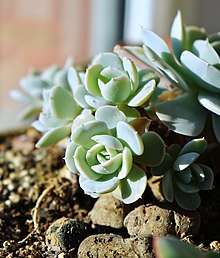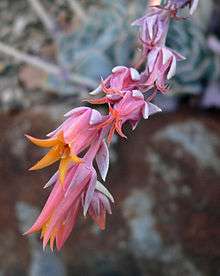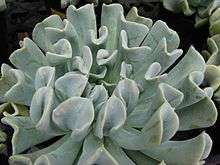Echeveria runyonii
Echeveria runyonii is a species of flowering plant in the family Crassulaceae,[1] that is native to the state of Tamaulipas in Mexico.[2] Several cultivars have been described and cultivated.
| Echeveria runyonii | |
|---|---|
 | |
| Scientific classification | |
| Kingdom: | Plantae |
| Clade: | Tracheophytes |
| Clade: | Angiosperms |
| Clade: | Eudicots |
| Order: | Saxifragales |
| Family: | Crassulaceae |
| Genus: | Echeveria |
| Species: | E. runyonii |
| Binomial name | |
| Echeveria runyonii | |
Taxonomy and Etymology
Joseph Nelson Rose described Echeveria runyonii in 1935,[1] named in honour of Texas amateur botanist Robert Runyon.[3] Runyon had collected the type specimen from a Matamoros, Tamaulipas garden[4] in 1922.[5][6] Wild populations were unknown until 1990, when one was discovered by the staff of Yucca Do Nursery.[7]
The cytology of Echeveria species is helpful in identification, as many species can be very variable in appearance; E. runyonii has 14 chromosomes.[1]
Echeveria is named for Atanasio Echeverría y Godoy, a botanical illustrator who contributed to Flora Mexicana.[8]
Description

Echeveria runyonii forms a rosette 8–10 cm (3.1–3.9 in) in diameter. Leaves are spatulate-cuneate to oblong-spatulate, truncate to acuminate, and mucronate. They are a glaucous pinkish-white in color and measure 6–8 by 2.5–4 cm (2.4–3.1 by 1.0–1.6 in). The single stem reaches 10 cm (3.9 in) in length or more and a diameter of roughly 1 cm (0.39 in). Inflorescences are 15–20 cm (5.9–7.9 in) tall and have 2 – 3 cincinni, conspicuous bracts, and pedicels approximately 4 mm long. The red flowers have ascending-spreading sepals to 11 mm and pentagonal corollas measuring 19 – 20 × 10 mm.[1]
Echeveria peacockii has similar-coloured glaucous leaves, but its leaves are wedge-shaped with mucronulate (pointed) tips.[9]
Cultivars

Several named cultivars exist, including 'Texas Rose', 'Dr. Butterfield', 'Lucita', 'Tom Allen', and 'Topsy Turvy'. The last is a mutant form originated in California, with leaves positioned upside-down.[10]
Hybrids
- Echeveria 'Domingo' (E. cante × E. runyonii)[11]
- Echeveria 'Green Star' (E. harmsii × E. runyonii 'Topsy Turvy')[12]
- Echeveria 'Swan Lake' (E. shaviana × E. runyonii 'Topsy Turvy')[13]
- Echeveria 'Glade Surprise' (E. derenbergii × E. runyonii 'Topsy Turvy')[14]
- Echeveria 'Dagda' (E. pulvinata 'Frosty' × E. runyonii 'Topsy Turvy')[15]
- Echeveria 'Exotic' (E. laui × E. runyonii 'Topsy Turvy')[16]
References
- Kimnach, Myron (2003). Urs Eggli (ed.). Illustrated Handbook of Succulent Plants. Volume 6: Crassulaceae. Birkhäuser. pp. 103, 122. ISBN 9783540419655.
- Kimnach, Myron (January 2001). "Three varieties of Echeveria cuspidata". Cactus and Succulent Journal. 77 (1): 28–33.
- Eggli, Urs; Newton, Leonard E. (2004). Etymological Dictionary of Succulent Plant Names. Birkhäuser. p. 207. ISBN 3540004890.
- Scheick, William (July–August 2012). "Echeverian Beauty among the Rocks". Texas Gardener.
- "Isotype of Echeveria runyonii Rose, J.N. 1935 [family CRASSULACEAE]". JSTOR Plant Science. JSTOR. 2011-05-25. JSTOR 01014098.
- "Echeveria runyonii Rose ex E. Walther". Collections Search Center. Smithonian Institute. Retrieved 2012-07-01.
- Finkel, Marty (October 2010). "Plant of the month Echeveria 'Topsy Turvy'" (PDF). The Garden Path. Archived from the original (PDF) on 2016-03-04. Retrieved 2012-07-02.
- Gledhill, David (2008). "The Names of Plants". Cambridge University Press. ISBN 9780521866453 (hardback), ISBN 9780521685535 (paperback). p. 149
- Cactus and Succulent Society of America (1998). Haseltonia: yearbook of the Cactus and Succulent Society of America, Issues 6-10. p. 81.
- "RUNYONII Rose ex Walther, 1935". International Crassulaceae Network. Archived from the original on 2013-01-15. Retrieved 2012-07-01.
- "Domingo". International Crassulaceae Network. Archived from the original on 2013-01-15. Retrieved 2012-07-01.
- "Green Star". International Crassulaceae Network. Archived from the original on 2013-01-15. Retrieved 2012-07-01.
- "Swan Lake". International Crassulaceae Network. Archived from the original on 2013-01-16. Retrieved 2012-07-01.
- "Glade Surprise". International Crassulaceae Network. Archived from the original on 2013-01-15. Retrieved 2012-07-01.
- "Dagda". International Crassulaceae Network. Archived from the original on 2013-01-15. Retrieved 2012-07-01.
- "Exotic". International Crassulaceae Network. Archived from the original on 2013-01-15. Retrieved 2012-07-01.
External links
